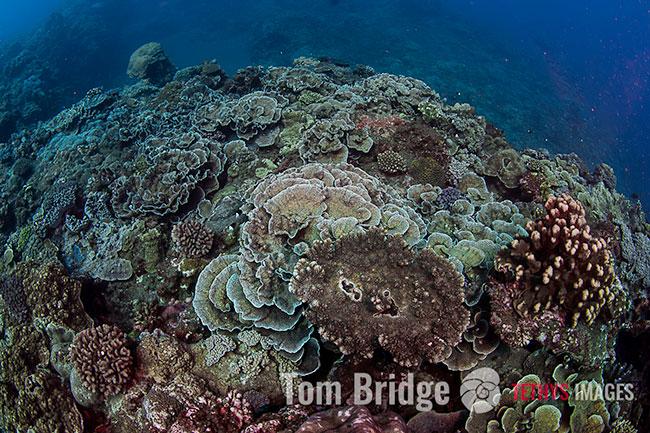
A population of coral reefs is making a remarkable recovery around the newest island on Earth, Hunga Tonga – Hunga Ha’apai (HTHH), after it was formed during a volcanic eruption in 2015.
The island is 200m high and connects the neighbouring islands of Hunga Tonga and Hunga Ha’apai.
The finding was made by a team of scientists recently, who were studying the effects of the eruption on coral reef diversity around the island.
The team included NASA Goddard Space Flight Centre chief scientist Dr Jim Garvin, lead author Patrick Smallhorn-West, who is a PhD candidate at the ARC Centre of Excellence for Coral Reef Studies at James Cook University (Coral CoE at JCU), and a National Geographic Explorer, and co-author Tom Bridge, also from Coral CoE at JCU.
“Coral reefs are increasingly compromised by multiple stressors, even in the most remote locations,” said Mr Smallhorn-West.
“So, while severe disturbances, such as volcanic eruptions, can annihilate entire reef ecosystems, they can also provide unique opportunities to examine ecosystem resilience and recovery. We wanted to see what happens to a coral reef when it experiences the worst of the worst. Not much is as bad as a massive volcanic eruption, short of the French nuclear test detonations at Bikini Atoll, and this allowed us to document not only how reefs were affected by a massive disturbance, but also how they recovered.”
Co-author Tom Bridge, from Coral CoE at JCU, said the reefs were surveyed not only to examine the effects of the eruption, but also to understand how new reefs begin forming on the habitat that is now available around the new island.
To piece together the environmental conditions that were present at the time of the eruption, NASA's Dr Garvin explained that large ash clouds from the eruption collapsed into a ground hugging flow that released massive sediment plumes into the ocean. This was confirmed both by scans of rock samples that were collected from the island and by satellite imagery, which also showed high sea temperatures around the eruption.
They found that while some parts of the reef were totally annihilated by the eruption with huge chunks of reef turned over, at the same time one section of the island was unaffected.
“Here we found high coral cover and many large mature coral colonies, this was a well-established reef system that had clearly been unaffected by the eruption,” said Mr Bridge.
This section appeared to have provided a source of larvae to repopulate reefs around the rest of the island.
Mr Smallhorn-West said this is evidenced by the large number of juvenile corals that covered the substrate at many locations.
“Some of the uplifted land had also made brand new habitat for reef formation, and there was very high recruitment of specific fast-growing species in these areas, all very young and beginning to lay the foundations of a new reef.”
“Fish showed a similar pattern, with all the large fish persisting at the one site, and plenty of juveniles now living in the areas that were either annihilated or uplifted by the blast,” he added.
Resilience
The study also suggests that the remote location and lack of additional stressors, such as human activity, have likely contributed to the resilience of these reefs.
“In the absence of chronic man-made stressors such as poor water quality and overfishing, coral reefs can be resilient to one of the largest physical disturbances on Earth,” Mr Smallhorn-West said.
Natural disasters like these, that were once the largest catastrophes on Earth, may soon rate second to the human driven impacts of climate change.
This includes large-scale disturbances such as the mass coral bleaching of 2016 on the Great Barrier Reef, in Queensland, Australia.
Mr Bridge said huge areas were affected with few refuges available. And therefore, few prospects of recovery.
“Small and protected populations can be crucial for recovery from severe disturbances in marine as well as terrestrial ecosystems—but recovery is likely to decline as the frequency and severity of man-made disturbances continues to increase.”








